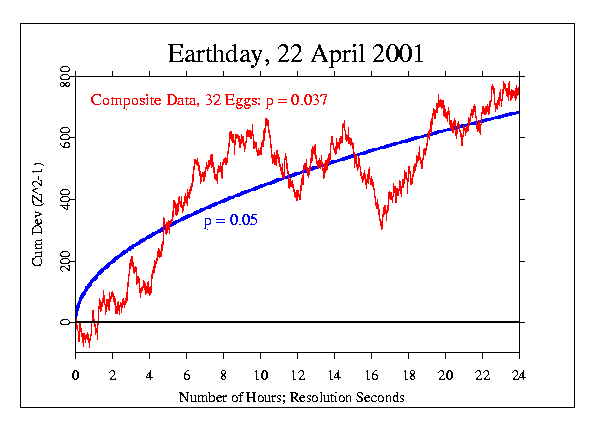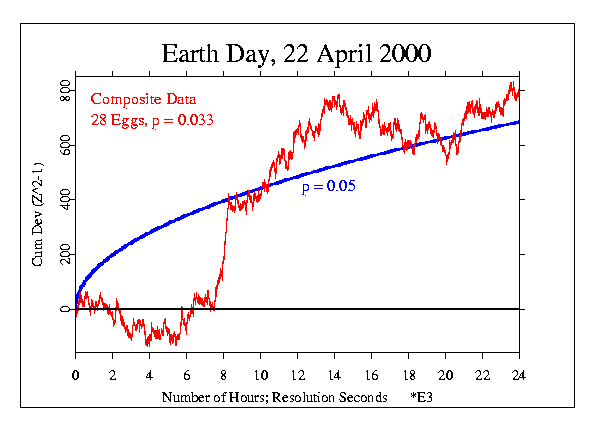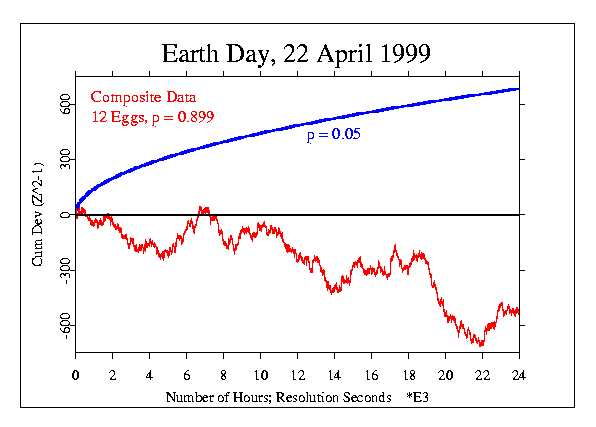Earth Day 2001 |
|
Earth Day is April 22, and this year it was on a Sunday. Since 1970, Earth Day has been an annual event for people around the world to celebrate the earth and our responsibility toward it. The Earthday network says, "Volunteer. Go to a festival. Install solar panels on your roof. Organize an event where you live. Change a habit. Help launch a community garden. Communicate your priorities to your elected representatives. The possibilities are endless! Do something nice for the earth, have fun, meet new people, and make a difference." Earth Day 2000 -- the 30th anniversary -- was expected to stir 500 million people on all continents and in more than 160 nations. Probably the expectations in 2001 should be similar. Despite the setback to global responsibility from the US refusal to cooperate with the Kyoto accords, there is a growing recognition that we must pay attention to the earth's needs.
Given the basic character of the Global Consciousness Project,
with purposes that include helping more people recognize
that we can have a better future by becoming more conscious
of our interdependence, Earth Day seems a natural event to examine.
Since the Earth Day observances are very diffuse, with no central, focal
moment, we decided that the most sensible prediction would be to simply
expect the whole day to show the effects of large numbers of separate
celebrations, rituals, meetings, and consciousness raising events. The
full 24 hours of data for 22 April, 2001, based on UTC time, were
extracted, and processed as raw second-by-second composites across all
eggs. At the time of processing (on the 23rd), 32 eggs had reported.
The figure below shows the cumulative deviation for the 24 hour period.
The total Chisquare was 87142 on
86400 degrees of freedom, for a p-value of 0.03733.
For a control comparison the
corresponding data from a pseudorandom source are available.
This result prompted us to look at Earth Day 2000, first using the Noosphere Cafe. Although the Cafe uses a compressed database, with minutes ( means of 60 seconds) instead of the raw seconds data, the result was strikingly similar, with an even greater deviation. This is the Cafe figure:
To compare more directly with the formal analysis, I
generated another figure for 2000 using the standard functions,
exactly duplicating the 2001 analysis using the raw
data. This too yielded a strong result, with p = 0.03288, and there is
again a general similarity of the trend, as the following figure shows.
Of course we also could go back to 1999 to see whether this might be a
repeatable outcome. As so often happens in studies of the anomalies
associated with consciousness, the simple expectations are most often
wrong. In this case, The Noosphere Cafe's
minute-level data showed only a modest deviation in 1999, while the raw
data actually have a trend opposite to our exploratory expectation.
There were 12 eggs running in April, and I made
the assumption that Earth Day was on April 22 in that year also (as far
as I know it is always April 22).
The trend for 1999 is not significantly backward, but it suggests a tempered
interpretation of the other years. Once again we have what appears to
be a generalizable result that is not strictly repeatable. As usual,
the possibilities range from a conclusion that there is no effect, to
an effect buried by chance in the noise. Again patience is required.
Here is a picture of the 1999 data in the raw seconds presentation.
|



